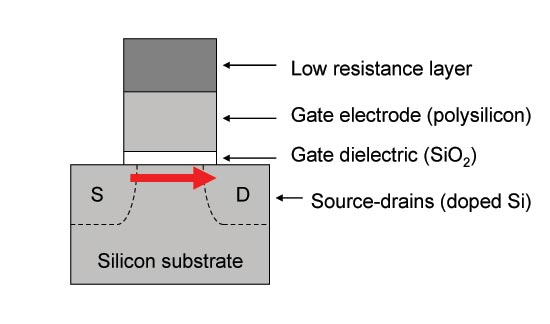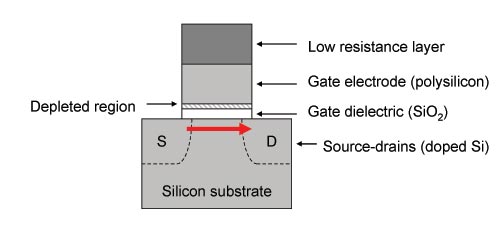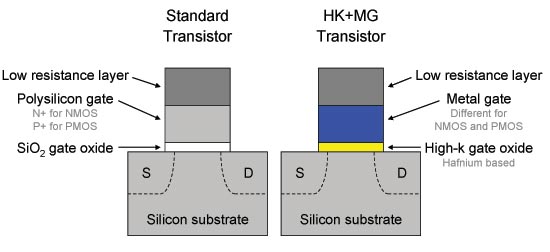Intel Demonstrates new 45nm Transistors and Conroe's Successor
by Anand Lal Shimpi on January 27, 2007 12:00 AM EST- Posted in
- CPUs
More Efficient Transistors
The basic function of a transistor as found in modern day microprocessors is to act as a switch with two states: on and off. When the transistor is on, current is allowed to flow from one terminal to the other (source to drain), and when it is off current shouldn't flow. Making enough current flow when it should and minimizing the amount that flows when it shouldn't is one of the major hurdles to making smaller transistors that run cooler/faster.
Below we have a typical CMOS transistor diagramed and labeled:

The voltage present at the Gate and the Source will determine whether or not current will flow in the transistor. Intel's 45nm process makes significant changes to two of the components in this transistor diagram: the gate electrode and the gate dielectric.
You can probably guess that as transistors get smaller, all of the parts of the transistor get smaller as well. The problem is that when some of these features get too small, they start behaving inappropriately. Case in point is the gate dielectric; with Intel's 90nm and 65nm processes, the gate dielectric was shrunk to a thickness of 1.2nm - the equivalent of about 5 atoms. The benefit of a very thin gate dielectric is that it increases the gate field effect, which increases drive current and reduces Source-drain leakage current. However, with such a thin gate dielectric electrons can tunnel directly through the layer and show up as leakage current - in other words, current would flow when it was not supposed to, translating into power wasted. On an individual transistor scale it's not such a big deal, but when you keep in mind that Penryn will have around 410 million of these transistors (820 million for quad-core) the leakage current/power draw does add up.
At 1.2nm, the gate oxide/gate dielectric in Intel's 90nm and 65nm transistors was as thin as Intel could make it without losing a great deal of power due to gate oxide leakage current. In order to make the move to 45nm Intel had to do something to thin the gate oxide without drastically increasing gate oxide leakage current.
Intel solved the gate oxide leakage problem by replacing the SiO2 gate dielectric with a material that has a higher k-value, in this case a Hafnium based material. A high-k dielectric here actually increases drive current at the same thickness as the previous SiO2 dielectric, while reducing gate leakage as well. Intel isn't disclosing how thick the Hafnium gate dielectric layer is in its 45nm transistors, but we do know that it is thicker than the 1.2nm SiO2 gate dielectric used in previous 90nm and 65nm transistors.

The second problem Intel is addressing with its 45nm transistors is a fundamental issue with the polysilicon gate electrode. The role of the gate electrode is important as it is what enables current to be driven through the transistor and as such it plays a role in how much current can be delivered. The polysilicon material that the gate electrode is made of has a tendency to form a region of depleted conducting carriers at the bottom of the gate, which reduces the drive strength of the transistor (less current flows when it needs to).

Intel's new 45nm transistors solve this problem by replacing the polysilicon gate electrode with a metal gate electrode, which completely eliminates the depleted region thus increasing the drive current.
Intel has been researching this High-k + Metal Gate (HK+MG) combination in transistors for a handful of years now, with hundreds of material options for metal gate electrodes and high-k dielectrics. The actual combination of high-k and metal gate material isn't being disclosed at this time, most likely to protect Intel's research and maintain the manufacturing advantage as long as possible. Intel expects that no other company will have HK+MG transistors until they reach 32nm or later.

The tangible advantages of these changes in materials in combination with the smaller 45nm process are quite large. According to Intel, the move from 65nm to 45nm yields a 30% reduction in transistor switching power because of the simple fact that smaller transistors have less parasitic capacitance and require less power to switch on and off.
Because of the combination of a high-k dielectric and the metal gate electrode, Intel is quoting a greater than 20% improvement in switching speed compared to its 65nm transistors. At the same speed as its 65nm transistors, there's a greater than 5x reduction in source-drain leakage power and a greater than 10x reduction in gate oxide leakage power; the latter is due entirely to the use of a high-k dielectric in the transistor. The end results of all of this are more power efficient processors, the first of which we should see by the end of this year.










59 Comments
View All Comments
mostlyprudent - Saturday, January 27, 2007 - link
Do we have any info as to chipset/socket compatability for Penryn?MarkM - Saturday, January 27, 2007 - link
Whoa Nelly!!! They JUST achieved a first validation sample of the material, what, SIX HOURS AGO? Lord knows when they'll even have chipset details figured out, and a shipping CPU is still a year off.This is a moment to step back and marvel at the continued long term achievement of the semiprocessor industry, not obsess how your going to run Vista!
mino - Saturday, January 27, 2007 - link
Well, AMD stated that K8L will be drop-in compatible with SocketF/AM2 insrastructure in May 2006(if not sooner).That seems pretty much a yer ago from expected shipment date of mid-2007.
This was presented not only to public but also to its corporate customers! ...
To answer the original question:
Do not expect penryn to work with anything older than 965 series of chipsets on boards introduced by 2H07 or later.
mino - Saturday, January 27, 2007 - link
Meaning, ofcourse, that one should not expect penryn to be drop-in compatible with any current boards.Andrwken - Monday, January 29, 2007 - link
Actually, considering they are using unmodified hardware to run the chips. I would be rather surprised if they did not work on any core 2 capable motherboard. Correct me if I'm wrong, but a well researched motherboard purchase could get you a mobo that can run any 775 socket Prescook, Core 2 (dual or quad), and possibly Penryn? That's a pretty good lifecycle for a socket. How many has amd had in the last 2 years?JarredWalton - Monday, January 29, 2007 - link
I believe Penryn is scheduled for launch around the same time as Bearlake, and in the past we have seen a lot of official Intel platforms require a new chipset - whether or not the requirement is strictly necessary is obviously a different story. I believe Core 2 Duo is supposed to "require" P/G/Q965 or 975X, or one of a few select 945/946 chipset versions. Obviously, with 865 and 915 boards out there supporting the new CPUs, Intel's requirement was not strictly necessary, but most boards for C2D still use 965 or 975. What will happen with Penryn? I have no doubt we'll see some 965/975 boards that support it, but I'll be pleasantly surprised if the official requirement doesn't include Bearlake.Viditor - Tuesday, January 30, 2007 - link
I believe that Bearlake is out 3-6 months before Penryn (Q2-3 for Bearlake), but your point is taken...
mostlyprudent - Saturday, January 27, 2007 - link
Sorry for the pragmatic obsessiveness...cannot be helped!MarkM - Saturday, January 27, 2007 - link
No problem, I hope I didn't come off sounding more negative than I meant to be! Anyway I just happened to stumble on a partial answer to your question:http://www.dailytech.com/article.aspx?newsid=5869">linkflyck - Saturday, January 27, 2007 - link
IBM and AMD (who work together) already stated that they have a simular technology, http://www.eetimes.com/news/semi/showArticle.jhtml...">linkSo don't say doomed yet -_-